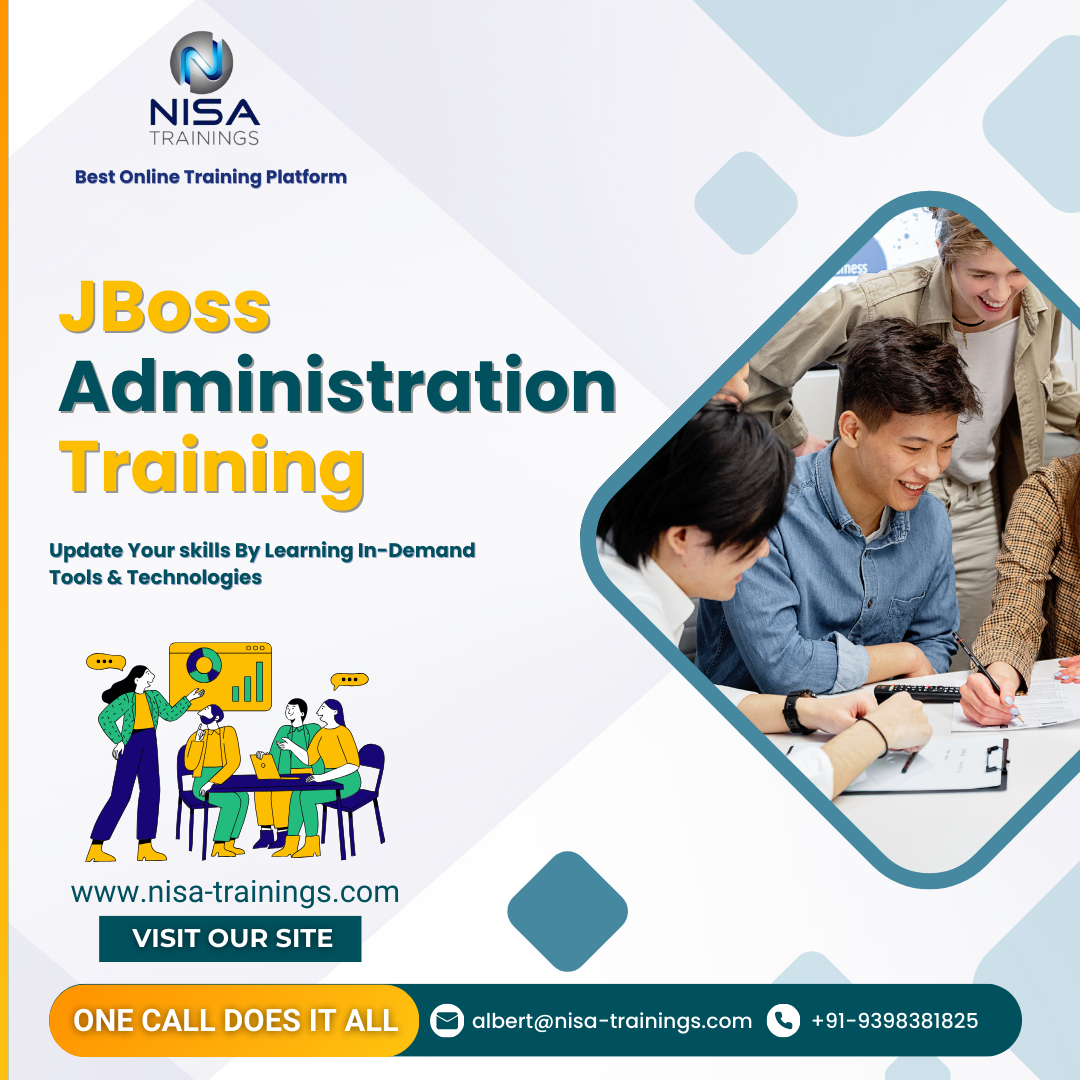JBoss Administration Training

Why should you choose Nisa For JBoss Administration Training?
Nisa Trainings is the best online training platform for conducting one-on-one interactive live sessions with a 1:1 student-teacher ratio. You can gain hands-on experience by working on near-real-time projects under the guidance of our experienced faculty. We support you even after the completion of the course and happy to clarify your doubts anytime. Our teaching style at Nisa Trainings is entirely hands-on. You’ll have access to our desktop screen and will be actively conducting hands-on labs on your desktop.
Job Assistance
If you face any problem while working on JBoss Administration Course, then Nisa Trainings is simply a Call/Text/Email away to assist you. We offer Online Job Support for professionals to assist them and to solve their problems in real-time.
The Process we follow for our Online Job Support Service:
- We receive your inquiry for Online Job
- We will arrange a telephone call with our consultant to grasp your complete requirement and the tools you’re
- If our consultant is 100% confident in taking up your requirement and when you are also comfortable with our consultant, we will only agree to provide service. And then you have to make the payment to get the service from
- We will fix the timing for Online Job Support as mutually agreed by you and our consultant.
Course Information
JBoss Administration Training
Duration: 25 Hours
Timings: Weekdays (1-2 Hours per day) [OR] Weekends (2-3 Hours per day)
Training Method: Instructor Led Online One-on-One Live Interactive
Sessions.
COURSE CONTENT :
Module 1: Introduction to JBoss EAP
Overview of JBoss EAP
- What is JBoss EAP?
- Key components and architecture of JBoss EAP
- Understanding the role of JBoss EAP in Java EE development
- Differences between JBoss EAP and WildFly
- Key features of JBoss EAP
Understanding Java EE and Application Servers
- Overview of Java EE specifications (JPA, JMS, etc.)
- Java EE application server requirements and JBoss EAP capabilities
Module 2: Installation and Setup
Installing JBoss EAP
- Platform requirements and installation prerequisites
- Installing JBoss EAP on Linux and Windows systems
- Using JBoss EAP installation wizard
- Verifying successful installation
Configuring JBoss EAP
- Basic configuration files (standalone.xml, domain.xml)
- Configuring JBoss using the JBoss CLI (Command Line Interface)
- Configuring system properties and JVM options
- Setting up logging and enabling debugging features
Setting Up a Multi-Node JBoss EAP Cluster
- Cluster setup for high availability and load balancing
- Configuring domain mode vs standalone mode
- Setting up and managing cluster nodes
Module 3: Deploying Applications
Application Deployment Techniques
- Deploying web applications (WAR files)
- Deploying enterprise applications (EAR, JAR files)
- Understanding deployment directories and file structure
- Managing deployments using JBoss CLI and JBoss Admin Console
Deployment Best Practices
- Automating deployment through scripts
- Rollback and undeploying applications safely
- Hot deployments and zero-downtime deployments
Configuring Virtual Hosts and Multiple Applications
- Configuring virtual hosts to run multiple applications
- Managing server interfaces (HTTP, HTTPS, etc.)
- Load balancing between applications
Module 4: Configuration and Management
Configuring Data Sources
- Setting up JDBC connections and data sources
- Configuring connection pooling for database connections
- Understanding XA transactions and their configuration
Managing JMS (Java Message Service)
- Configuring JMS queues and topics
- Setting up JMS connection factories
- Managing messaging services for asynchronous communication
Web Services and Application Security
- Configuring web services (SOAP, REST)
- Securing applications with SSL and TLS
- Setting up authentication and authorization mechanisms (LDAP, Database, etc.)
Module 5: Security Management
Authentication and Authorization
- Integrating JBoss with LDAP/Active Directory for authentication
- Configuring JBoss security realms
- Role-based access control (RBAC) and securing resources
- Enabling secure communication with SSL/TLS
Managing User Permissions
- Configuring security domains and roles
- Fine-grained access control for applications and services
- Security auditing and event logging
Module 6: Performance Tuning and Monitoring
Monitoring JBoss EAP Performance
- Using the JBoss Admin Console and CLI for monitoring server status
- Analyzing performance metrics (CPU, memory, threads)
- Identifying and addressing performance bottlenecks
Performance Tuning
- Configuring thread pools and memory management
- Tuning JVM garbage collection settings
- Load balancing strategies and optimization
Using JBoss Tools and Monitoring Tools
- Overview of JBoss Operations Network (JON)
- Using JConsole, VisualVM, and other profiling tools
- Setting up and managing JBoss Management Console
Module 7: Clustering and Load Balancing
Understanding JBoss Clustering
- Cluster architecture and its components (mod_cluster, JGroups)
- Configuring session replication for failover
- Enabling distributed caching and state replication
Load Balancing in JBoss
- Configuring mod_cluster for load balancing
- Setting up reverse proxy with Apache HTTP Server
- Scaling applications with multi-node clusters
- Configuring automatic failover and load balancing policies
Module 8: Troubleshooting and Log Management
Log Management and Analysis
- Understanding JBoss log files and log levels
- Configuring logging for applications and server
- Analyzing server logs and interpreting log data
Common Issues and Troubleshooting Techniques
- Identifying and resolving common deployment issues
- Troubleshooting JVM crashes, memory leaks, and performance issues
- Diagnosing and solving configuration problems
Advanced Troubleshooting with JBoss CLI
- Using CLI for troubleshooting and system health checks
- Using JBoss CLI commands for real-time server analysis
Module 9: Backup, Recovery, and Upgrades
System Backup and Recovery
- Backup procedures for JBoss EAP configuration and application data
- Restoring backups and disaster recovery processes
Upgrades and Patches
- Upgrading from older versions of JBoss EAP to newer versions
- Patching JBoss EAP for security fixes and feature updates
- Ensuring minimal downtime during upgrades
Module 10: Advanced Topics (Optional)
Integration with Other Systems
- Integrating JBoss EAP with external systems (LDAP, databases, message brokers)
- Monitoring and management integrations
JBoss EAP and Cloud Environments
- Configuring JBoss EAP for cloud deployments (AWS, OpenShift, etc.)
- Setting up Docker containers for JBoss EAP deployment
- Continuous integration and deployment (CI/CD) with JBoss EAP

